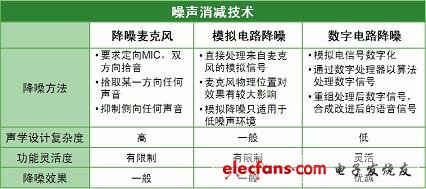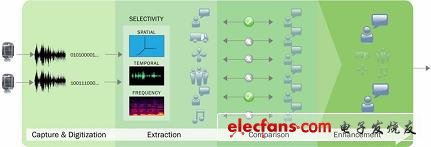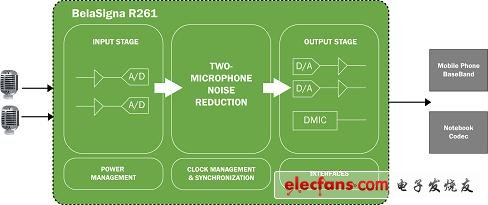In recent years, the market for mobile / portable devices such as smartphones and notebook computers has continued to develop rapidly. While these products continue to integrate more new functions to enhance the user experience, there is still plenty of room for improvement in the user experience of basic voice communication functions, especially in noisy environments to improve voice clarity while maintaining natural voice fidelity. For example, when a user walks in a crowded commercial street, the surrounding environment may be full of car horns, engine roar, construction noise, noisy crowd noise, footsteps and even wind noise. When using a mobile phone to make a voice call, the traditional technology It is difficult to provide a clear voice communication effect. In addition, manufacturers are also adding video calling capabilities to emerging tablet PCs. When using these mobile / portable devices for teleconferences, the surrounding environment may also include a variety of noises, such as noisy human voices in the office, surrounding conversations, computer noises, stroke noises, and glassware knocking sounds. The call effect is also not easy.
In these applications, to reduce or filter environmental noise and improve voice communication effects, different methods can be used, such as special noise reduction microphones, analog circuit noise reduction or digital circuit noise reduction (see Table 1). These methods have their own characteristics. In comparison, the noise reduction method using digital circuits is flexible, the acoustic design complexity is low, and the noise reduction effect is superior. Of course, in addition to providing good noise reduction effects, portable device designers are also faced with various design constraints and challenges, such as size, energy consumption, physical acoustic design, audio fidelity, and cost.
Table 1: Comparison of different noise reduction techniques.

Advanced dual microphone real-time adaptive noise reduction technology
ON Semiconductor recently introduced the BelaSigna R261 high-performance voice capture system-on-chip (SoC) based on digital circuit noise reduction technology. The device uses advanced dual microphone noise reduction technology, which can help the design to provide excellent noise reduction effect (see Figure 1). This advanced signal processing technology accepts the signals of two microphones, can distinguish different types of signals, extract effective voice information and suppress environmental noise, thereby improving voice recognition.

Figure 1: BelaSigna R261 uses an advanced real-time adaptive noise reduction algorithm.
BelaSigna R261 has a speech extraction algorithm built into its integrated ROM memory. This algorithm uses one or more sensors to extract the waveform propagation signal without the need to know the sound source or sensor position in advance. This scheme uses global optimization criteria and works in the frequency, time, and space domains at the same time. There is no limit to the number of sound sources and the number of sensors, which is independent of the signal-to-noise ratio (SNR), that is, it can be used in low SNR and high SNR environments. It also works optimally, and is very suitable for applications such as mobile phones and portable computers that need to extract useful speech signals from different noise domains.
This adaptive noise suppression algorithm provides 25 dB of noise suppression capability, which can separate the required speech and environmental noise in real time. It is suitable for various voice sources and voices in various positions, while ensuring natural sound quality (after other solutions) (Unnatural sound, not full), can effectively work with microphones of various qualities.
Analysis of key features of BelaSigna R261
BelaSigna R261 is a high-performance voice capture SoC that integrates a digital signal processor (DSP), voltage regulator, phase-locked loop (PLL), level shifter, and ROM memory. Such a high level of integration is comparable to other solutions By comparison, the bill of materials (BOM) can be reduced. As shown in Figure 2, this device supports dual microphone direct input, noise reduction algorithm is built into the integrated ROM memory, DSP-based application controller provides high performance and ultra-low energy consumption, provides dual-pass analog output, and supports digital microphones Output. In addition, the built-in power management module supports supply voltages from 1.8 V to 3.3 V, the built-in on-chip PLL provides multiple frequency options, and also provides an I2C interface.

Bitmain is the world's leading digital currency mining machine manufacturer. Its brand ANTMINER has maintained a long-term technological and market dominance in the industry, with customers covering more than 100 countries and regions. The company has subsidiaries in China, the United States, Singapore, Malaysia, Kazakhstan and other places.
Bitmain has a unique computing power efficiency ratio technology to provide the global blockchain network with outstanding computing power infrastructure and solutions. Since its establishment in 2013, ANTMINER BTC mining machine single computing power has increased by three orders of magnitude, while computing power efficiency ratio has decreased by two orders of magnitude. Bitmain's vision is to make the digital world a better place for mankind.
Bitmain Antminer:Bitmain Antminer KA3 (166Th),Bitmain Antminer L7 (9.5Gh),Bitmain Antminer Z15,Bitmain Antminer D7 (1286Gh),
Bitmain Antminer S19 XP (140Th),Bitmain Antminer E9 (2.4Gh),Bitmain Antminer Z11,Bitmain Antminer S3,Bitmain Antminer L3+ (504Mh)
Bitmain Antminer,S19 Pro Hyd 198T,antminer bitmain,antin s19j,antminer miner
Shenzhen YLHM Technology Co., Ltd. , https://www.hkcryptominer.com